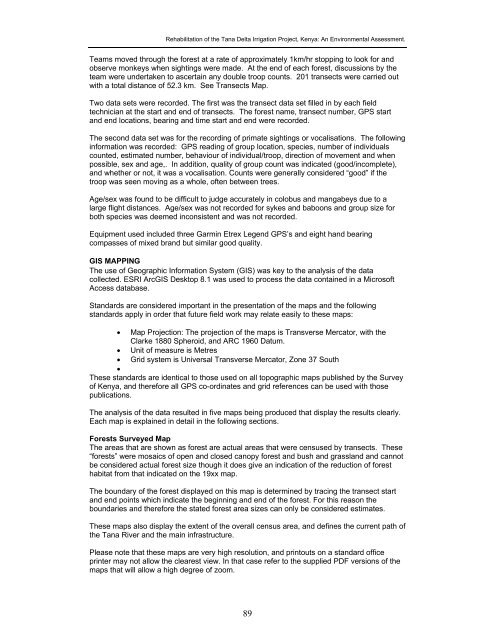Tana Delta Irrigation Project, Kenya: An Environmental Assessment
Tana Delta Irrigation Project, Kenya: An Environmental Assessment
Tana Delta Irrigation Project, Kenya: An Environmental Assessment
You also want an ePaper? Increase the reach of your titles
YUMPU automatically turns print PDFs into web optimized ePapers that Google loves.
Rehabilitation of the <strong>Tana</strong> <strong>Delta</strong> <strong>Irrigation</strong> <strong>Project</strong>, <strong>Kenya</strong>: <strong>An</strong> <strong>Environmental</strong> <strong>Assessment</strong>.<br />
Teams moved through the forest at a rate of approximately 1km/hr stopping to look for and<br />
observe monkeys when sightings were made. At the end of each forest, discussions by the<br />
team were undertaken to ascertain any double troop counts. 201 transects were carried out<br />
with a total distance of 52.3 km. See Transects Map.<br />
Two data sets were recorded. The first was the transect data set filled in by each field<br />
technician at the start and end of transects. The forest name, transect number, GPS start<br />
and end locations, bearing and time start and end were recorded.<br />
The second data set was for the recording of primate sightings or vocalisations. The following<br />
information was recorded: GPS reading of group location, species, number of individuals<br />
counted, estimated number, behaviour of individual/troop, direction of movement and when<br />
possible, sex and age,. In addition, quality of group count was indicated (good/incomplete),<br />
and whether or not, it was a vocalisation. Counts were generally considered “good” if the<br />
troop was seen moving as a whole, often between trees.<br />
Age/sex was found to be difficult to judge accurately in colobus and mangabeys due to a<br />
large flight distances. Age/sex was not recorded for sykes and baboons and group size for<br />
both species was deemed inconsistent and was not recorded.<br />
Equipment used included three Garmin Etrex Legend GPS’s and eight hand bearing<br />
compasses of mixed brand but similar good quality.<br />
GIS MAPPING<br />
The use of Geographic Information System (GIS) was key to the analysis of the data<br />
collected. ESRI ArcGIS Desktop 8.1 was used to process the data contained in a Microsoft<br />
Access database.<br />
Standards are considered important in the presentation of the maps and the following<br />
standards apply in order that future field work may relate easily to these maps:<br />
• Map <strong>Project</strong>ion: The projection of the maps is Transverse Mercator, with the<br />
Clarke 1880 Spheroid, and ARC 1960 Datum.<br />
• Unit of measure is Metres<br />
• Grid system is Universal Transverse Mercator, Zone 37 South<br />
•<br />
These standards are identical to those used on all topographic maps published by the Survey<br />
of <strong>Kenya</strong>, and therefore all GPS co-ordinates and grid references can be used with those<br />
publications.<br />
The analysis of the data resulted in five maps being produced that display the results clearly.<br />
Each map is explained in detail in the following sections.<br />
Forests Surveyed Map<br />
The areas that are shown as forest are actual areas that were censused by transects. These<br />
“forests” were mosaics of open and closed canopy forest and bush and grassland and cannot<br />
be considered actual forest size though it does give an indication of the reduction of forest<br />
habitat from that indicated on the 19xx map.<br />
The boundary of the forest displayed on this map is determined by tracing the transect start<br />
and end points which indicate the beginning and end of the forest. For this reason the<br />
boundaries and therefore the stated forest area sizes can only be considered estimates.<br />
These maps also display the extent of the overall census area, and defines the current path of<br />
the <strong>Tana</strong> River and the main infrastructure.<br />
Please note that these maps are very high resolution, and printouts on a standard office<br />
printer may not allow the clearest view. In that case refer to the supplied PDF versions of the<br />
maps that will allow a high degree of zoom.<br />
89

















